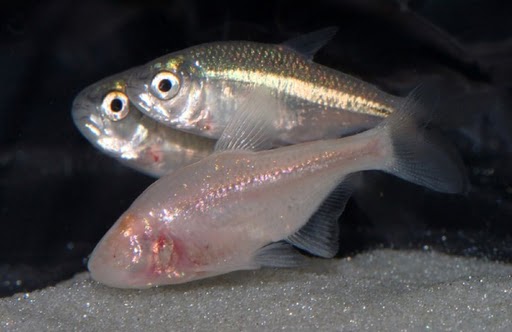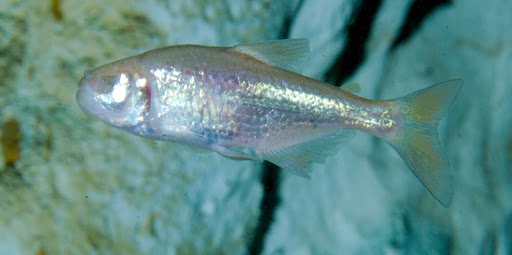The Mexican tetra developed the ability to live without sight when its relatives that lived on the surface shifted to living in dark limestone caves during the Pleistocene period.
Before we dive into the scientific reasons behind this unique blind fish, let me entertain you with a joke.
 A silly joke! I agree
A silly joke! I agree
It’s not uncommon to come across a blind fish among a group of fish. Some individuals are simply born without eyes.
But are there any species where not having eyes is a natural part of their evolution?
Allow me to introduce you to Astyanax mexicanus, also known as the Mexican Blind Cavefish or the Blind Cave Tetra. They spend the majority of their lives in complete darkness. Their eyes degenerate because the species didn’t follow the “use it or lose it” principle of evolution.
So why did the species undergo such drastic changes? And are they blind from birth?
The Mexican Blind Cavefish
 The Mexican tetra (Photo Credit : Grand-Duc/Wikimedia commons)
The Mexican tetra (Photo Credit : Grand-Duc/Wikimedia commons)
The thought of entering a cave without a flashlight and navigating through the pitch darkness can be unsettling. However, the Mexican tetra has evolved the ability to live without sight. During the Pleistocene period, the surface-dwelling (epigean) Astyanax fishes moved to live in limestone caves between central Mexico and south Texas. Over time, their descendants lost their eyes and pigmentation, and became known as the cave-dwelling (hypogean) Mexican tetra.
 Regions where Astyanax mexicanus is found (Photo Credit : MiguelCampos /Wikimedia commons)
Regions where Astyanax mexicanus is found (Photo Credit : MiguelCampos /Wikimedia commons)
As a result, a single species—Astyanax mexicanus—branched into two types: the surface-dwelling fish with eyes and the cave-dwelling fish without eyes. The Mexican cavefish is a teleost fish belonging to the order Characiformes. They are troglodytes, meaning they live their lives in the darkness of caves in North Mexico.
Like most troglodytes, Mexican cavefish have characteristics such as blindness, loss of pigmentation, heightened tactile and chemical senses, advanced ability to find food, reduced energy requirements, attraction to vibrations, shorter lifespan, decreased genetic diversity, and smaller population sizes.
Are Mexican Cavefish Born Without Eyes?
Mexican cavefish follow a similar process of eye formation as their surface-dwelling relatives A. mexicanus. The cavefish initially develop a small rudimentary eye during the first 24 hours of embryonic development. However, soon after, the eye development stops and regressive changes begin, including eye degeneration and loss of pigmentation.
 Two surface-dwelling Astyanax mexicanus and a blind cave-dwelling Mexican tetra (Photo Credit : Richard Borowsky /Wikimedia commons)
Two surface-dwelling Astyanax mexicanus and a blind cave-dwelling Mexican tetra (Photo Credit : Richard Borowsky /Wikimedia commons)
The first indication of degeneration is the apoptosis (cell death) of the lens, followed by retinal degeneration. Eventually, the eyes sink into the sockets and non-pigmented scales cover them, just like the rest of the body.
What Leads to Vision Loss?
The loss of vision in the Mexican tetra is caused by specific gene mutations known as “master switches”. These switches control the development of eyes in the Mexican cavefish. One particular switch can disable the eye gene, rendering it useless. In the cavefish, this master switch is referred to as “shh”.
It is important to note that “shh” is not a secret or a reference to a cartoon character. Instead, it is the abbreviation for the sonic hedgehog molecule (Shh), which is a signaling molecule.
 The incorrect form of sonic hedgehog (Photo Credit: Pixabay)
The incorrect form of sonic hedgehog (Photo Credit: Pixabay)
The “shh” molecule is a powerful morphogen that determines the fate of cells in the developing brain. It not only affects eye development but also plays a role in the formation of the forebrain in the cavefish.
During the early stages of embryogenesis, the “shh” signals from the anterior midline of the neural plate determine the expression of certain genes such as Pax6, Pax2, and Vax1. These genes are crucial for the formation of tissues and organs during embryogenesis. An increased level of shh signaling leads to eye degeneration, while a lack of shh signals results in slightly larger eyes.
In the case of the cavefish, there is an observed increase in shh signaling levels. This causes an imbalance in the levels of Pax6, Pax2, and Vax1. These genes are responsible for determining the distance between the two eyes and the size of the optic cups. This imbalance leads to the formation of smaller optic cups and longer optic stalks. The over-expression of shh signals leads to the apoptosis of the lens and halts eye development.
 The blind cavefish (Photo Credit: Flickr)
The blind cavefish (Photo Credit: Flickr)
However, the full understanding of the cellular and molecular mechanisms involved in this mutation is still not complete.
Why Does This Mutation Occur?
All organisms undergo and continue to undergo the process of evolution. Some organisms lose ancestral characteristics to adapt to their changing environment. The loss of the human tailbone is a well-known example. Similarly, the cavefish lost its eyes and pigmentation due to the evolution of the species. While the exact explanation for this mutation is still unknown, there are currently three theories explaining the regressive changes in the cavefish.
- Direct natural selection: This theory suggests that the loss of eyes in the Mexican tetra is a result of the species’ habitat, which is a dark cave. In this environment, eyes do not provide any visual advantage to the species. Instead, the absence of eyes helps conserve energy as food sources are scarce in caves. Maintaining eye tissues and optic nerves requires a significant amount of metabolic energy.
- Indirect selection: This theory involves the concept of pleiotropy, where a single gene mutation affects multiple traits. The Shh signaling in cavefish negatively affects the development of eyes but has positive effects on the development of taste buds. An increase in the number of taste buds allows the fish to find food more effectively. Therefore, the species had to trade vision for an enhanced sense of taste.
- Genetic drift: This hypothesis suggests that natural selection did not play a role in the observed mutation in the Mexican tetra. Instead, the genetic mutation occurred randomly.
However, none of these theories have been definitively proven yet.
Summary
The cavefish made a deal with evolution, sacrificing their eyes in exchange for enhanced senses that increase their chances of survival in the Mexican caves. They developed additional taste buds that aid in locating food more efficiently in the absence of light. Furthermore, they have evolved an improved mechano-sensory system, enabling them to perceive their surroundings through vibrations.
In conclusion, being blind has proven to be a significant advantage for the species of Astyanax Mexicanus that dwell in caves.
